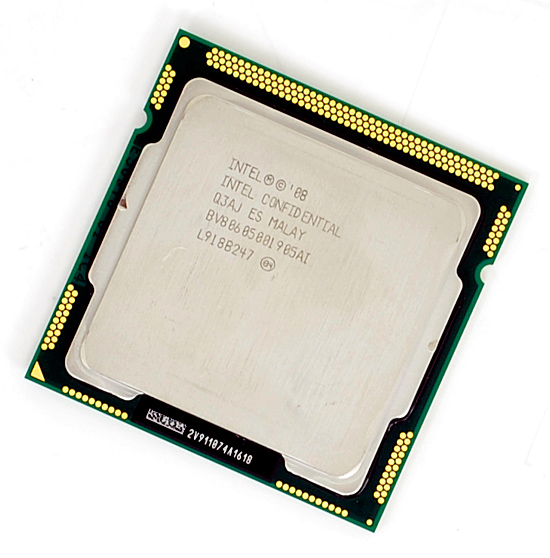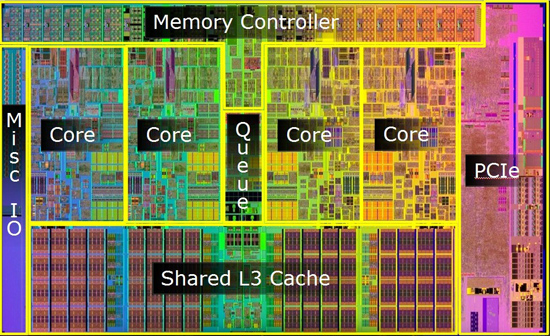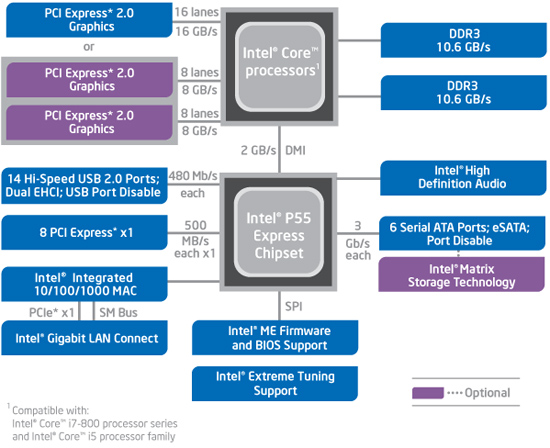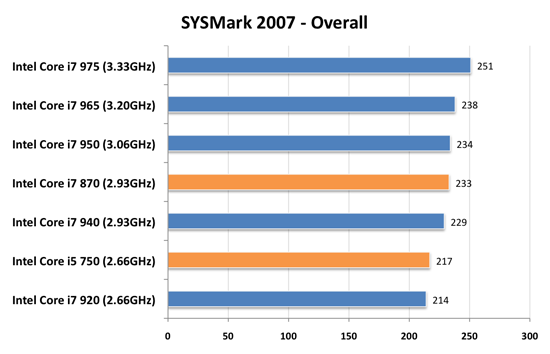Intel's Core i7 870 & i5 750, Lynnfield: Harder, Better, Faster Stronger
by Anand Lal Shimpi on September 8, 2009 12:00 AM EST- Posted in
- CPUs
Intel is on the verge of transitioning to 32nm. We'll see the first parts this year. What do you do with your 45nm fabs when you start moving volume away from them? Make really cheap quad-core Nehalems of course:

I'm talking $196. I'm talking faster than AMD's entire lineup. I'm talking about arguably the best processor of 2009. I'm talking about Lynnfield, and here's its backside:

Mmm
I spent much of the past year harping on AMD selling Nehalem-sized Phenom IIs for less than Intel sold Nehalems. With Lynnfield, Intel actually made Nehalem even bigger all while driving prices down. Like I said, what do you do when you're still making boatloads of money in a recession and are about to start emptying your 45nm fabs?
I should clear things up before we progress much further. Lynnfield is the codename for mainstream 45nm quad-core Nehalem, while Bloomfield refers to the first Nehalem launched at the end of 2008:
| Processor | Manufacturing Process | Die Size | Transistor Count | Socket |
| Bloomfield | 45nm | 263 mm2 | 731M | LGA-1366 |
| Lynnfield | 45nm | 296 mm2 | 774M | LGA-1156 |
Despite being cheaper, Lynnfield is larger than Bloomfield. The larger die is due to one major addition: an on-die PCIe controller.

Bloomfield, The First Nehalem, circa 2008

Lynnfield, Nehalem for All, circa 2009
The pink block to the right of the die is the PCIe controller, that's 16 PCIe 2.0 lanes coming right off the chip. Say hello to ultra low latency GPU communication. You'd think that Intel was about to enter the graphics market or something with a design like this.
Sacrifices were made to reduce CPU, socket and board complexity. Gone are the two QPI links that each provided 25.6GB/s of bandwidth to other CPUs or chips on the motherboard. We also lose one of the three 64-bit DDR3 memory channels, Lynnfield only has two like a normal processor (silly overachieving Bloomfield).

Intel's Bloomfield Platform (X58 + LGA-1366)
The sum is that Lynnfield is exclusively single-socket; there will be no LGA-1156 Skulltrail. While the dual-channel memory controller isn't really a limitation for quad-core parts, six and eight core designs may be better suited for LGA-1366.

Intel's Lynnfield Platform (P55 + LGA-1156)
The loss of QPI means that Lynnfield doesn't have a super fast connection to the rest of the system, but with an on-die PCIe controller it doesn't matter: the GPU is fed right off the CPU.
The Lineup
We get three Lynnfield CPUs today: the Core i7 870, Core i7 860 and the Core i5 750. Intel's branding folks told us that the naming would make sense one we saw the rest of the "Core" parts introduced; yeah that was pretty much a lie. At least there aren't any overlapping part numbers (e.g. Core i5 860 and Core i7 860).
The i7 in this case denotes four cores + Hyper Threading, the i5 means four cores but no Hyper Threading. The rules get more complicated as you bring notebooks into the fray but let's momentarily bask in marginal simplicity.
| Processor | Clock Speed | Cores / Threads | Maximum Single Core Turbo Frequency | TDP | Price |
| Intel Core i7-975 Extreme | 3.33GHz | 4 / 8 | 3.60GHz | 130W | $999 |
| Intel Core i7 965 Extreme | 3.20GHz | 4 / 8 | 3.46GHz | 130W | $999 |
| Intel Core i7 940 | 2.93GHz | 4 / 8 | 3.20GHz | 130W | $562 |
| Intel Core i7 920 | 2.66GHz | 4 / 8 | 2.93GHz | 130W | $284 |
| Intel Core i7 870 | 2.93GHz | 4 / 8 | 3.60GHz | 95W | $562 |
| Intel Core i7 860 | 2.80GHz | 4 / 8 | 3.46GHz | 95W | $284 |
| Intel Core i5 750 | 2.66GHz | 4 / 4 | 3.20GHz | 95W | $196 |
Keeping Hyper Threading off of the Core i5 is purely done to limit performance. There aren't any yield reasons why HT couldn't be enabled.
Intel was very careful with both pricing and performance of its Lynnfield processors. I'm going to go ahead and say it right now, there's no need for any LGA-1366 processors slower than a Core i7 965:

This is only one benchmark, but it's representative of what you're about to see. The Core i7 870 (LGA-1156) is as fast, if not faster, than every single LGA-1366 processor except for the ones that cost $999. Its pricing is competitive as well:

For $196 you're getting a processor that's faster than the Core i7 920. I'm not taking into account motherboard prices either, which are anywhere from $50 - $100 cheaper for LGA-1156 boards. I don't believe LGA-1366 is dead, but there's absolutely no reason to buy anything slower than a 965 if you're going that route.










343 Comments
View All Comments
snakeoil - Tuesday, September 8, 2009 - link
what part of stock speed you don't understand?if you are going to compare 2 processors both must have a fixed stock speed, if you increase the frequency of one of them by 1Ghz over the stock speed that is illegal.
or either both have a stock fixed speed to benchmark or both are overclocked.
overclocking is the same it doesn't matter if it's auto overclocking or manual overclocking.
we the people demand justice.
we the people are not stupid.
Anand Lal Shimpi - Wednesday, September 9, 2009 - link
You may find that your desire for fixed speed comparisons will become difficult in the future. Both AMD and Intel are going to be embracing this sort of an approach to clock speeds.Overclocking is not the same as what is happening with turbo mode. Overclocking is not officially supported by the manufacturer, it is running a part faster than it was sold at in order to improve performance. If an application crashes because you've overclocked your chip too far that's no fault of the manufacturer.
Turbo mode runs the chip at a frequency it's guaranteed to work at, it's operating within spec. It simply re-allocates thermal resources; Intel could disable 3 of the cores and sell a Core i7 870 as a 3.6GHz single-core processor, or disable 2 of the cores and sell it as a 3.47GHz processor, or only disable one core and sell it as a 3.2GHz processor. Instead of making the end user choose, instead you get a dynamic processor that can configure itself in real time depending on the workload.
This is in stark contrast to AMD's Overdrive utility which is actually overclocking. The chips aren't validated at the overdrive speeds and you're thus overclocking. Lynnfield is validated at both its standard clock speed and its turbo speeds, just like Bloomfield. So long as you don't exceed the TDP of the chip, it will work at those turbo frequencies. The things that will prevent it from turboing were outlined in the article.
Once again, I am not increasing the speed of anything - Lynnfield is simply working as designed. Whether it's in a Dell machine or in a custom build, it will always work this way. It's what the end user will see the moment they turn on a Lynnfield machine. The end user would not see the same from a Core 2 or a Phenom II based machine.
Take care,
Anand
Jamahl - Wednesday, September 9, 2009 - link
The problem with this review is it has a bunch of graphs with intel cpus with speeds rated at a lot lower than what they actually are.When you show a graph of an i5 @ 2.66 gigahertz beating a 3.4 gigahertz phenom II, that is false and that is a problem. This cpu was not ever at 2.66 gigahertz for any of these tests was it?
I suggest there is a problem with your reviewer also, not to mention his attitude about 'having a laugh' because i brought up this point?
Anand Lal Shimpi - Wednesday, September 9, 2009 - link
Again, that is the default clock of the processor - in many cases (especially the heavily threaded tests) it will be running at that speed. Turbo mode is dynamic, it's impossible to put down exactly what speed the chip was running at as it'll change throughout each test.You might see the chip run at 2.66GHz for several seconds, jump up to 3.46GHz then down to 3.2GHz, up to 3.6GHz and then back down to 2.66GHz all in the course of a single benchmark. It's repeatable, but there's no way to display all of that in a bar chart.
Take care,
Anand
snakeoil - Wednesday, September 9, 2009 - link
What you are doing is cheating, and people is not stupid.you are saying that lynnfield is faster than phenom 2 because lynnfield is overclocked at least 600 mhz.
people is not stupid as you think, and what you are doing is outrageous.
if you are going to benchamark with turbo enabled then you have to overclock phenom 2 at least the same 600 mhz.
show some respect for your readers. or are you really on intel's payroll?
Klober - Wednesday, September 9, 2009 - link
I am usually very respectful on the AnandTech and DailyTech forums and comments areas, but you sir are exactly as stupid as you are claiming people "is" not. Please read the article from beginning to end before continuing on your unjustified tirade. The processor is being used as intended by the manufacturer - to not test it in this way would be a disservice to the engineers who designed it and the company that produces it.snakeoil - Wednesday, September 9, 2009 - link
if you dont want to disable turbo the overclock phenom 2 at least 600 mhz.just to be fair.
Gary Key - Wednesday, September 9, 2009 - link
"if you dont want to disable turbo the overclock phenom 2 at least 600 mhz.just to be fair. "
You do realize that it takes near zero or sub-zero cooling to run the 965BE in stable manner at 4GHz with a 64-bit OS. When I say stable, I mean 24/7 multi-tasking, not a CPUZ screenshot or a SuperPi 1M bench. AMD has not solved this problem with the current stepping.
Once again, and for the last time, Intel's turbo function is a standard feature of the processor. AMD will be offering the exact same technology in their next processor family.
snakeoil - Wednesday, September 9, 2009 - link
that's not true.we demand justice and fair benchmarks.
you are losing all credibility and these benchmarks are worthless and unreal.
goinginstyle - Wednesday, September 9, 2009 - link
How many times do they have to respond to you in a logical manner. You should be banned and in some countries that would mean a beheading for being so damn stupid.